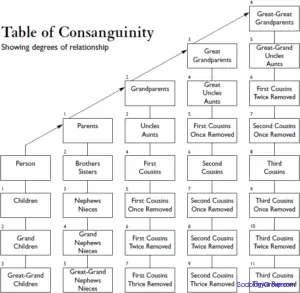kinship organization in India: Every individual has relationships with other people around them. this is the basic system that takes place in all human societies. it organizes people and groups and therefore it is known as the system of kinship. Radcliffe Brown viewed kinship as a part of the social structure and gave importance to the study of the kinship system as a part of rights and obligations (1964). The study of Nuer of southern Sudan done by Evans Pritchard was determined on kinship groups. Essentially focused on a descent in the male line from the ancestor.
Every kinship system is significantly a cultural system. There no particular pattern in this world for any kinship system. It tends to vary from one culture to another culture.
Read Kinship: Meaning, Types and Importance

Kinship in India can be seen in families and outside families. Primary relatives focus on kinship within the family including initial intrafamily relationships containing husbands and wife, mother and daughter, brother and sister, father and son, etc. These all are part of the same nuclear family which is also known as “family of procreation”.
Outside the kinship of family, there are secondary and tertiary relatives. Murdock showcases primary ‘8’ and secondary ‘33’ relatives. Each of the secondary relatives contains primary relatives.
In India in general perspective, we have “clan exogamy” and “caste endogamy”. There are cases that have different clans and these clans have different lineages. In the common ancestor of a lineage member is a common and known person by everyone but in a common ancestor of the clan has a supernatural being. All the members of a clan are distributed over different areas and that is why they do not find common interest among each other.
Clans facilitate a foundation for corporate functions, love on the premise of the group, in marriage qualification inside a given standing is resolved.
It is believed that kinship is basically a vital part of the social organization also at the same period it set division with regards to the inheritance of property. There is a reason which hampers the lineage unity and results in conflicts between members. The rivalry between brothers or argument between father and son all are been observed.
Read: Key Concepts in Kinship!
Iravati Karve’s Study on Kinship in India

Iravati Karve uses a comparative analysis to look out the four cultural zones with an idea to conclude on the regional pattern of social behavior in society. The different regions may show different local patterns. There are different types of caste due to the hierarchy and caste division and separation. Karve looks after all the process of accommodation and acculturation in the field of kinship. She analyzed 3000 years based on ethnic sources, folk literature, observations, and Sanskrit texts.
Points that gained Karve’s consideration:
- Kinship in terms of Indian languages.
- Behavior and attitudes in the context of language
- Rules of Descents and inheritance
- Marriage and family patterns
- Comparative study on Sanskritic north and Dravidian south
To understand the pattern of kinship in India Karve explains the configuration of the linguistic areas, caste institution, and organization of family as the most essential. She breakdown the whole nation into central, northern, southern, and eastern keeping in mind the languages used, caste and organization of the family.
North India and Kinship:
In northern India, we have (a) blood relation (b) affinal relations. There are essential terms for three ages of immediate relations and the terms for single age cannot be exchanged for those people who are from another generation.
The Northern part of India contains Punjabi, Hindi, Sindhi, Assami, Bihari, Bengali, and Nepali. In these parts clan exogamy, caste endogamy and taboos related to sexual relations between primary relations are practiced.
Here the rule of sasan is followed in which a person cannot marry in his patri family and also avoid marriages with the sapindra relation. Brahmanic has Gotras which are an exogamous unit. At times these castes are also classified into exogamous and endogamous gotras.
Features of northern kinship in India
Endogamy gets restricted when caste is a concern. Marriage on a large scale of the area gets blocked.
Brahmanas and other upper castes practice the avoidance of fathers, mothers, grandmother and maternal grandmothers gotras in north India. Also known as the rule of Four gotras.
Kinship and Central India
It includes areas like Rajasthan, Gujarat, Kathiawad, Chattisgarh, Orissa, Maharashtra their languages being Rajasthani, Gujarati, Kathiawadi, Oriya, and Marathi. Somehow these languages are related to Sanskrit and are placed in the northern area of India.
There are three main points to be kept in mind while learning about the northern areas.
- The Northern area does not allow cross-cousin marriages.
- Exogamous clans have divided into different castes.
- In some of the castes, exogamous clans are stratified in hypergamous rank.
Also, it is not necessary that all these points are existing in all the regions of north India. For instance in Rajasthan Jats follow the ruling of two gotra exogamy and village exogamy. Four gotra rules are followed by Banias and hypergamous clans are in Rajputs and here for marriage feudal status is a significant consideration.
kinship in South India
The regions that come under south India are Andhra Pradesh, Karnataka, Tamil Nadu, Kerala, and other regions that have people with different languages. It is complex to study the southern areas as they are dominated by the patrilocal and patrilineal system and in some areas matrilineal and matrilocal systems.
If we compare southern and northern kinship we can state that in southern areas we can say there is no difference between the family of birth and the family of marriage and in northern part we have a clear-cut difference.
So here we see marriages are used to strengthen the kin relationships with one another. In south India, there are two sets of a line that guide people or descents with whom one can marry and second with whom one cannot marry.
Mandelbaum, explains Dravidian kinship terminology “can be derived from a few postulates, a principal one being that the children of brother and sister should marry. The term used for cross-cousin of the opposite sex (a man’s mother’s brother’s daughter and usually also his father’s sister’s daughter) has the connotation of a prospective or possible spouse. By extension, all potential mates are called cross-cousin”.
So, therefore, marriages are used to strengthen the ties among each other. It maintains unity and understanding among kin.
After all his analysis Nur Yalman says:
“ Brother and Sister must be separated but their offspring must also be united”
In southern India, the importance is given to bilateral links and little too territorial exogamy or nil.
Eastern India, kinship
The Eastern area has no specific borders and is not compact. Northern languages are prominent as well as other languages like Monkhmer and Mundari. Communities found here are Khmer, Mon, and Chain.
People with Mundari linguistic backgrounds have the patrilocal or patrilineal system. Ho and Santhal practice cross-cousin marriage but only the time till when the father’s sister or the mother’s brother is alive, marriage with the daughter is not allowed. Therefore cross-cousin marriage is rare to be seen. For example, Bondo people do not follow cross-cousin marriages.
In Assam Khasi’s speak Monkhmer language and they follow a matrilineal system like Nayars but they are not completely similar. In Nayar’s case matrilineal joint family exists and husband visits occasionally. Khasi’s have a joint family with a common worship place and graveyard but the husband-wife live in a small house of their own.
Hence, kinship is a complex component existing in society and the most fundamental principle of society. Different regions in India follow different types of kinship system and there are many factors which have brought changes in kinship such as migration, education, and mobility, etc.
Reference
Karve, I., 1994, “The Kinship Map of India”, in P. Uberoi (ed.), Family, Kinship and
Marriage in India. Delhi: Oxford University Press, Pp.50-73.
We believe in sharing knowledge with everyone and making a positive change in society through our work and contributions. If you are interested in joining us, please check our ‘About’ page for more information
